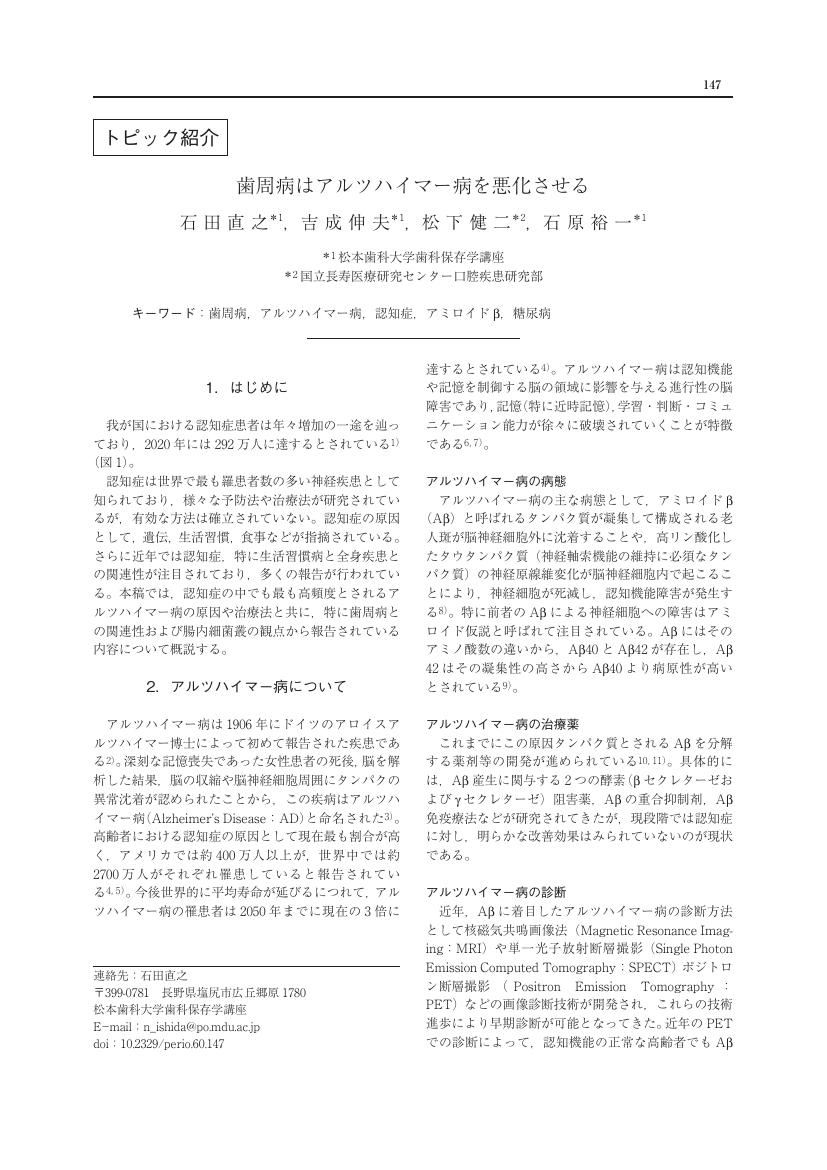38 0 0 0 OA 歯周病はアルツハイマー病を悪化させる
- 著者
- 石田 直之 吉成 伸夫 松下 健二 石原 裕一
- 出版者
- 特定非営利活動法人 日本歯周病学会
- 雑誌
- 日本歯周病学会会誌 (ISSN:03850110)
- 巻号頁・発行日
- vol.60, no.3, pp.147-152, 2018-09-28 (Released:2018-09-28)
- 参考文献数
- 44
- 著者
- 四釜 洋介 黒澤 実愛 松下 健二
- 出版者
- 一般社団法人 日本エンドトキシン・自然免疫研究会
- 雑誌
- エンドトキシン・自然免疫研究 (ISSN:24341177)
- 巻号頁・発行日
- vol.22, pp.40-42, 2019 (Released:2019-11-06)
- 参考文献数
- 9
Interleukin (IL) -29 is a cytokine belonging to the type Ⅲ interferon family, which regulates a similar set of genes as type Ⅰ interferons. Although type Ⅰ interferons act globally, type Ⅲ interferons primarily target epithelial cells and protect them against the frequent viral attacks that are common for barrier tissues. The antiviral effects of IL-29 have been demonstrated at barrier surfaces in the respiratory and gastrointestinal tracts, liver, blood-brain barrier, and skin, but it remains unknown whether IL-29 exhibits these effects in oral epithelial cells. In this study, we found that the functional IL-29 receptor, interferon-lambda receptor 1, is expressed in epithelial cells from both human oral mucosa and gingiva, but not in human gingival fibroblasts. Although IL-29 stimulation did not induce pro-inflammatory cytokine mRNA expression, such as IL-6 and IL-8, it did induce retinoic acid-inducible gene (RIG) -I and interferon gamma-inducible protein 16 (IFI-16) production via a signal transducers and activator of transcription 1 (STAT1) -dependent pathway in gingival epithelial cells. RIG-I and IFI-16 sense viral nucleic acids, and the stimulation of these receptors induces interferon beta production. Moreover, we confirmed that the augmenting effects of IL-29 on 5’triphosphate double-stranded RNA (a synthetic ligand for RIG-I) -induced interferon beta production in gingival epithelial cells. These data suggest the therapeutic potential of IL-29 for preventing viral infections in the oral mucosa.
- 著者
- 松下 健二 高藤 順 Kenji MATSUSHITA Jun TAKAFUJI
- 雑誌
- 吉備国際大学研究紀要(人文・社会科学系) = Journal of KIBI International University Humanities and Social Sciences
- 巻号頁・発行日
- no.増刊, pp.1-10, 2017-09-20
1 0 0 0 OA エキソサイトーシス制御を基盤とした新しい歯周病治療法の開発
- 著者
- 松下 健二 引頭 毅
- 出版者
- 国立長寿医療センター(研究所)
- 雑誌
- 基盤研究(B)
- 巻号頁・発行日
- 2007
歯周病の病因におけるエキソサイトーシスの意義とその制御の可能性について検討した。その結果、歯周病原細菌の種々の刺激は、歯周組織を構成する上皮細胞、免疫細胞、血管内皮細胞にエキソサイトーシスを誘導すること、またそれが一酸化窒素(NO)によって際御されることが明らかになった。
1 0 0 0 OA 型関節の回内・回外動作の節電図的研究 : キネシオロジー
1 0 0 0 IR 中学生の走り幅跳びの踏み切り指導における擬音語の有効性に関する研究
- 著者
- 松下 健二 藤田 定彦
- 出版者
- 兵庫教育大学
- 雑誌
- 実技教育研究 (ISSN:09138404)
- 巻号頁・発行日
- vol.15, pp.33-37, 2001

